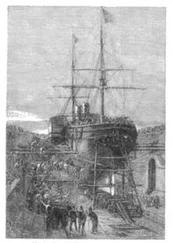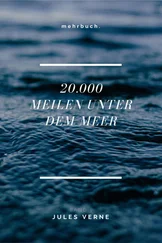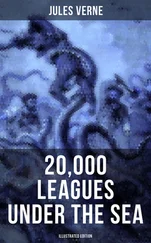Captain Nemo pointed to this prodigious heap of shellfish, and I saw that these mines were genuinely inexhaustible, since nature’s creative powers are greater than man’s destructive instincts. True to those instincts, Ned Land greedily stuffed the finest of these mollusks into a net he carried at his side.
But we couldn’t stop. We had to follow the captain, who headed down trails seemingly known only to himself. The seafloor rose noticeably, and when I lifted my arms, sometimes they would pass above the surface of the sea. Then the level of the oysterbank would lower unpredictably. Often we went around tall, pointed rocks rising like pyramids. In their dark crevices huge crustaceans, aiming their long legs like heavy artillery, watched us with unblinking eyes, while underfoot there crept millipedes, bloodworms, aricia worms, and annelid worms, whose antennas and tubular tentacles were incredibly long.
Just then a huge cave opened up in our path, hollowed from a picturesque pile of rocks whose smooth heights were completely hung with underwater flora. At first this cave looked pitch-black to me. Inside, the sun’s rays seemed to diminish by degrees. Their hazy transparency was nothing more than drowned light.
Captain Nemo went in. We followed him. My eyes soon grew accustomed to this comparative gloom. I distinguished the unpredictably contoured springings of a vault, supported by natural pillars firmly based on a granite foundation, like the weighty columns of Tuscan architecture. Why had our incomprehensible guide taken us into the depths of this underwater crypt? I would soon find out.
After going down a fairly steep slope, our feet trod the floor of a sort of circular pit. There Captain Nemo stopped, and his hand indicated an object that I hadn’t yet noticed.
It was an oyster of extraordinary dimensions, a titanic giant clam, a holy-water font that could have held a whole lake, a basin more than two meters wide, hence even bigger than the one adorning the Nautilus’s lounge.
I approached this phenomenal mollusk. Its mass of filaments attached it to a table of granite, and there it grew by itself in the midst of the cave’s calm waters. I estimated the weight of this giant clam at 300 kilograms. Hence such an oyster held fifteen kilos of meat, and you’d need the stomach of King Gargantua to eat a couple dozen.
Captain Nemo was obviously familiar with this bivalve’s existence. This wasn’t the first time he’d paid it a visit, and I thought his sole reason for leading us to this locality was to show us a natural curiosity. I was mistaken. Captain Nemo had an explicit personal interest in checking on the current condition of this giant clam.
The mollusk’s two valves were partly open. The captain approached and stuck his dagger vertically between the shells to discourage any ideas about closing; then with his hands he raised the fringed, membrane-filled tunic that made up the animal’s mantle.
There, between its leaflike folds, I saw a loose pearl as big as a coconut. Its globular shape, perfect clarity, and wonderful orient made it a jewel of incalculable value. Carried away by curiosity, I stretched out my hand to take it, weigh it, fondle it! But the captain stopped me, signaled no, removed his dagger in one swift motion, and let the two valves snap shut.
I then understood Captain Nemo’s intent. By leaving the pearl buried beneath the giant clam’s mantle, he allowed it to grow imperceptibly. With each passing year the mollusk’s secretions added new concentric layers. The captain alone was familiar with the cave where this wonderful fruit of nature was “ripening”; he alone reared it, so to speak, in order to transfer it one day to his dearly beloved museum. Perhaps, following the examples of oyster farmers in China and India, he had even predetermined the creation of this pearl by sticking under the mollusk’s folds some piece of glass or metal that was gradually covered with mother-of-pearl. In any case, comparing this pearl to others I already knew about, and to those shimmering in the captain’s collection, I estimated that it was worth at least 10,000,000 francs. It was a superb natural curiosity rather than a luxurious piece of jewelry, because I don’t know of any female ear that could handle it.
Our visit to this opulent giant clam came to an end. Captain Nemo left the cave, and we climbed back up the bank of shellfish in the midst of these clear waters not yet disturbed by divers at work.
We walked by ourselves, genuine loiterers stopping or straying as our fancies dictated. For my part, I was no longer worried about those dangers my imagination had so ridiculously exaggerated. The shallows drew noticeably closer to the surface of the sea, and soon, walking in only a meter of water, my head passed well above the level of the ocean. Conseil rejoined me, and gluing his huge copper capsule to mine, his eyes gave me a friendly greeting. But this lofty plateau measured only a few fathoms, and soon we reentered Our Element. I think I’ve now earned the right to dub it that.
Ten minutes later, Captain Nemo stopped suddenly. I thought he’d called a halt so that we could turn and start back. No. With a gesture he ordered us to crouch beside him at the foot of a wide crevice. His hand motioned toward a spot within the liquid mass, and I looked carefully.
Five meters away a shadow appeared and dropped to the seafloor. The alarming idea of sharks crossed my mind. But I was mistaken, and once again we didn’t have to deal with monsters of the deep.
It was a man, a living man, a black Indian fisherman, a poor devil who no doubt had come to gather what he could before harvest time. I saw the bottom of his dinghy, moored a few feet above his head. He would dive and go back up in quick succession. A stone cut in the shape of a sugar loaf, which he gripped between his feet while a rope connected it to his boat, served to lower him more quickly to the ocean floor. This was the extent of his equipment. Arriving on the seafloor at a depth of about five meters, he fell to his knees and stuffed his sack with shellfish gathered at random. Then he went back up, emptied his sack, pulled up his stone, and started all over again, the whole process lasting only thirty seconds.
This diver didn’t see us. A shadow cast by our crag hid us from his view. And besides, how could this poor Indian ever have guessed that human beings, creatures like himself, were near him under the waters, eavesdropping on his movements, not missing a single detail of his fishing!
So he went up and down several times. He gathered only about ten shellfish per dive, because he had to tear them from the banks where each clung with its tough mass of filaments. And how many of these oysters for which he risked his life would have no pearl in them!
I observed him with great care. His movements were systematically executed, and for half an hour no danger seemed to threaten him. So I had gotten used to the sight of this fascinating fishing when all at once, just as the Indian was kneeling on the seafloor, I saw him make a frightened gesture, stand, and gather himself to spring back to the surface of the waves.
I understood his fear. A gigantic shadow appeared above the poor diver. It was a shark of huge size, moving in diagonally, eyes ablaze, jaws wide open!
I was speechless with horror, unable to make a single movement.
With one vigorous stroke of its fins, the voracious animal shot toward the Indian, who jumped aside and avoided the shark’s bite but not the thrashing of its tail, because that tail struck him across the chest and stretched him out on the seafloor.
This scene lasted barely a few seconds. The shark returned, rolled over on its back, and was getting ready to cut the Indian in half, when Captain Nemo, who was stationed beside me, suddenly stood up. Then he strode right toward the monster, dagger in hand, ready to fight it at close quarters.
Читать дальше












